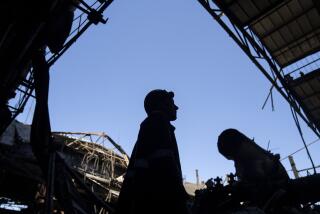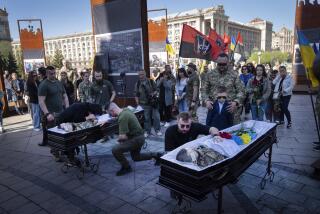Chernobyl Likened to A-Bomb Blast
- Share via
WASHINGTON — A top Soviet spokesman Sunday described the Chernobyl nuclear power plant disaster as having been “like one nuclear bomb explosion in the atmosphere.”
That frank description came from Georgy A. Arbatov, head of the Institute for the Study of the United States and Canada in the Soviet Ministry of Foreign Affairs. He was replying to questions on a British Broadcasting Corp. phone-in program.
“It was really a bad accident and information should have been given and was given,” Arbatov said in perhaps the closest thing yet to a Soviet apology for the Kremlin’s delay in disclosing that a major nuclear accident had occurred in the Ukraine. “Maybe there were some technical delays, I don’t know.”
Arbatov said the Soviets will release all information on the accident to Hanz Blix, director general of the Vienna-based International Atomic Energy Agency. Blix and two assistants, Deputy Director General Leonid Konstantinov and Dr. Martin Rosen, director of IAEA’s division of nuclear safety, are due to arrive in Moscow today.
Harold Denton, an expert with the U.S. Nuclear Regulatory Commission appearing on NBC’s “Meet the Press,” agreed with earlier statements by other experts that the Chernobyl accident was the “worst in history” of the use of nuclear reactors to generate electricity.
‘Russians Aren’t Telling Us’
“We don’t know exactly what happened,” Denton said of the Soviet disaster, which began more than a week ago, “because the Russians aren’t telling us.”
“We really never had a case like this before,” he emphasized. “That’s why it’s vital we get information from the Russians on what happened and what the impact has been. We’ve spent hundreds of millions of dollars in this country trying to simulate and calculate this sort of accident. This is something I hope the Russians will eventually give us a full scientific report on.”
The U.S. official said that he could only speculate that the graphite-moderated No. 4 reactor at Chernobyl “suffered some sort of loss of coolant activity, leading to a cladding (interior lining) failure, leading to a production of hydrogen and ultimately, explosion and fire.”
Denton, a member of the U.S. inter-agency task force set up to monitor the event, did not directly challenge Soviet assertions that only two people died in the accident and its aftermath, but he warned that more deaths may occur.
“I expect there are quite a few severely ill people, because we project lethal doses within the first several miles around,” he said. “It depends on their evacuation planning and how much advance warning they had.”
Three Towns Evacuated
Denton said that U.S. officials now know that three towns north of the Chernobyl plant were evacuated, but he was unable to confirm a Soviet statement that 49,000 people have been moved out of danger.
“That’s not been the focus of our look,” he said. “We’ve been trying to establish what got into the atmosphere so we can calculate the impact on the U.S. public here and abroad.”
Denton saw no danger for the United States if the fallout eventually arrives here, nor even for Japan, which began to report increases in radiation Sunday. Dispersal and decay have rendered the fallout cloud largely harmless, he said, explaining that it “moved north and then meandered around in Europe before coming toward us.”
What U.S. scientists surmise got into the atmosphere after the blowup, he said, was a “large amount of the most important radionuclides (that can threaten) health and safety.” He said this included “noble (inert) gases, cesiums, iodides, rubidiums--all the things that are of concern to health officials.”
Denton said the effect on unprotected humans within five to seven miles of the plant would be “severe” and there would be a “lot of fallout deposition” up to 30 miles away.
“There’s every indication there is widespread, serious contamination around that plant,” he said in an indirect comment on Saturday’s visit to Chernobyl by Soviet Premier Nikolai I. Ryzhkov and Politburo member Yegor K. Ligachev, who reportedly drank local water to demonstrate its safety. “A lot of the long-lived nuclides are going to be there for a long time, in the foodstuffs and in the water.”
More to Read
Sign up for Essential California
The most important California stories and recommendations in your inbox every morning.
You may occasionally receive promotional content from the Los Angeles Times.













